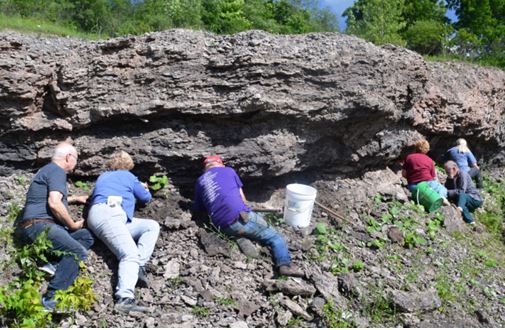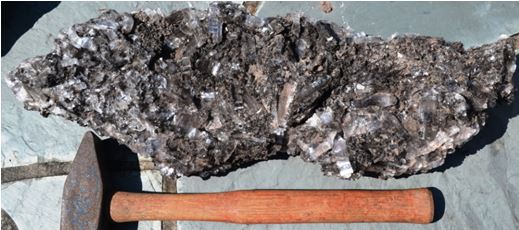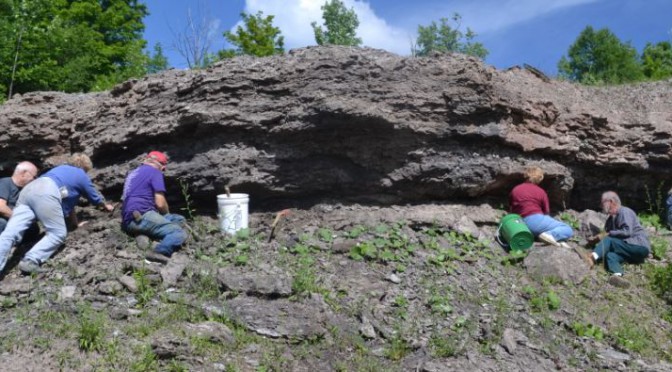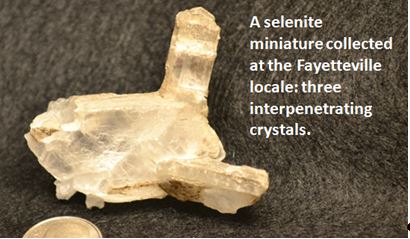Published in the July, 2015 WCGMC News
In late June, seven of us mineral enthusiasts set out for a day of collecting near Syracuse. We concluded the trip with a successful stop in Fayetteville where we recovered selenite. The site is behind the town municipal building on Route 257. The small outcrop is not a stand alone destination, but it does makes a nice ancillary stop on a trip into the area. For us, that meant a 90 minute stop after spending several hours in Ilion Gorge (our second visit there in a month). The Fayetteville ledge is not as pretty as the Ilion location, but it was a productive stop.
Selenite is the crystalline form of gypsum (CaSO4·2H2O). Crystals are monoclinic and generally colorless and transparent. They are tabular in nature and often interpenetrating. Clear selenite crystals and plates of crystals are intermixed with sanded and crusted massive gypsum and with clay. In the Fayetteville occurrence, the better crystals grew face down, adhering to a rigid limey lens in the host shale and growing into softer shale or clay below. The plates can be best extracted by removing the clay gently and then chiseling as large a piece as possible from the host rock. Gypsum is soft (2 on Mohs Hardness Scale) and can be scratched with a fingernail requiring that care be used during collecting and transport. Fingernails should be trimmed before collecting!

The drab shale units hosting the selenite lenses are part of the Camillus Formation of the Upper Silurian Salina Group. Predominantly an argillaceous (clay-rich) shale, the Camillus Formation was deposited in a very shallow inland sea during arid conditions when western New York was near the equator about 420 million years ago. At times the sea dried up and evaporate minerals (gypsum in this case) were precipitated. The selenite is often encrusted with dried mud that can be removed and the selenite layers alternate with mottled shales and clay units. There are occasional limestone units when the water depth was deep enough for a sufficient amount of time for them to form.

A modern analog for the Upper Silurian of western New York is an arid region of Northern Egypt where gypsum is being deposited in coastal lagoonal setting adjacent to the Nile River. It is interesting to note that similar environment conditions in Upper Silurian time led to the precipitation of the thicker salt (halite) units exploited for rock salt across western New York. The American Rock Salt Mine in Mt. Morris, NY was the WCGMC News Site of the Month in January (Jan2015 WCGMC News).
References:
Haynes, S.J., and Hughes-Pearl, J., 1991, Depositional Setting of Gypsum Deposits, SW Ontario, in Carbonates and Evaporites, v.6, #2, p. 193-216.
Stone, B. W., et.al., 1920, Gypsum Deposits of the United States, USGS Bulleting 697.


Can you say where in Fayetteville you were digging? I live there and my 7 year old son is very interested in finding crystals. Not sure if you have any suggestions on where we could go to have a reasonable chance of finding something. Thanks!
Rob, The site is in back of the DPW building at 5572 N. Manlius St. I have only been there on a Sunday and we just parked in front and walked to the low grey ridges in back of the dumped material behind the building. But I am told that if you visit during the day when someone is there they do let folks walk back behind the building to collect. There are horizontal seams in the limestone that contain the selenite. They are sand coated, but they are crystals and it is easy to dig there. Be careful with your son with the trash that must be crossed to reach the outcrop.